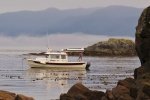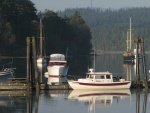T.R. Bauer":1jrkjgbs said:
If you're really worried about being able to call 911, just rent a sat phone for the trip as you can do that.
Regarding the original post, which was about using a VHS radio kayaking. I am mostly a kayaker/canoer, and previously and currently paddle much more than I motor my C-Dory.
Before you invest in or rent (lots of $) a satphone, realize the limitations. There are some, and under less-than-ideal conditions, including during paddling where there is wind and waves, those limitations may render a voice radio or satphone useless.
I have an Iridium satphone fairly longterm and I have not renewed subscription plans since I got used to the satellite messanging on my GPS. Initially, I loved this thing, and used it to contact my students and coworkers (i.e. "bring a shovel"). I once used it to call for a pickup during a weeklong class (10 students, 2 teachers) backpacking trip when I had a behavioral problem with a student.
I also have two portable VHS radios. Inside a boat cabin, or at times where it is quiet, you CAN use the Iridium or radios very well, but kayaking and anywhere there is wind you will be reduced to "repeat, repeat, repeat" and hearing "repeat, repeat, repeat" from the other side.
In some cases, you will absolutely NOT be able to communicate by voice. You will be trying to find a place that is out of the wind.
You will likely NOT be able to use either satphone or radio if you flip into the water during anything but calm conditions, and in that case, you probably won't flip.
Sometimes, the Iridium just didn't work when I wanted it. I needed to wait for a stronger satellite signal. No such problem so far with the Garmin.
When I took boy scouts to paddle the Bowron Lake circuit in BC once, maybe 15 years ago, I took my Iridium. During orientation, I mentioned I had it. The ranger told me to "please pack that thing away and don't take it out. Do not try to communicate to us with it". They then mentioned a satellite phone call they got a few years earlier that resulted in a full-blown rescue because they couldn't understand what was being said over the satphone. It wasn't a serious emergency, just a sprained wrist.
On my latest Bowron trip they said if possible to use their own rescue system if not life-threatening, but if it was really bad to use the emergency feature of the Garmin or other rescue beacon. The Garmin operators would be able to see exactly where the message originated from on a map and would then call the Park emergency number and law enforcement/emergency numbers. It would likely take seconds.
BTW; the Garmin links to most portable phones, including my iPhone, which I use for navigation. That makes entering text easy.
I do not work for Garmin. There may be other options, but I probably won't ever take that Iridium satphone on a kayak trip again. I do take my VHS radio. It can be useful where there are other boats navigating in larger water, though I really haven't seen that much kayaking except in Florida Bay, where nobody seems to be listening. I've contacted tugs here in Puget Sound to make sure they see me. They do respond. I would suggest Kayakers in 10,000 islands/Florida Bay or other large water areas to have a blaze orange signal flag to make themselves more visible when a boat is approaching. In my experience, Floridians and Gulf powerboaters motor intoxicated a lot. A signal flag (like used for waterskiing) could save your life.
Enjoy 10,000 islands! Take lots of bug spray and sunscreen!



